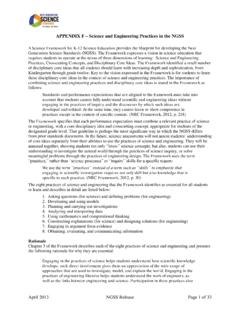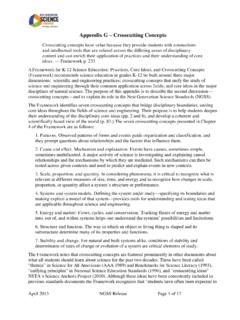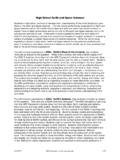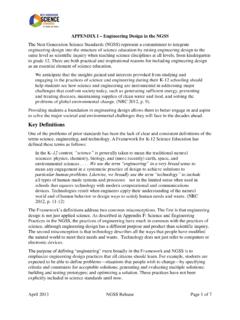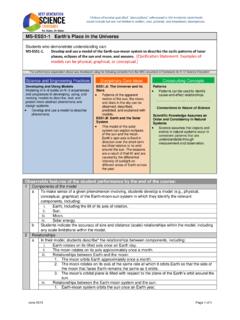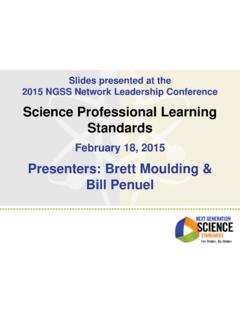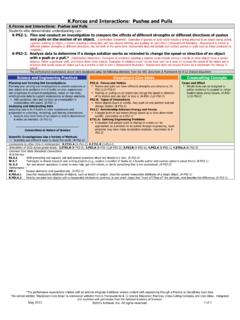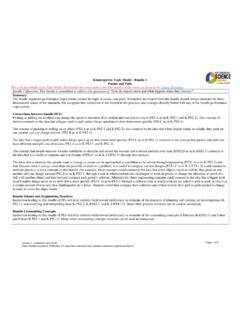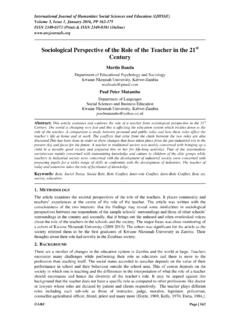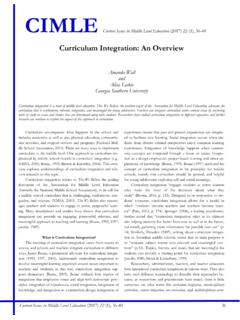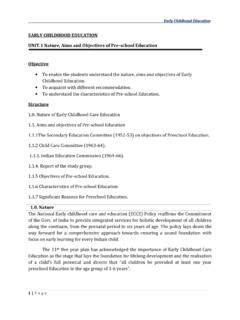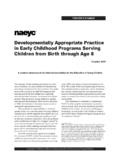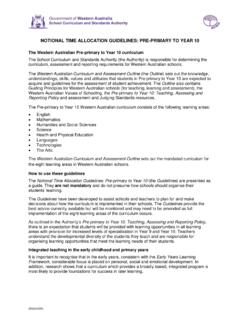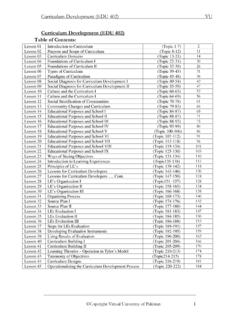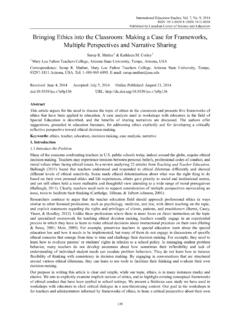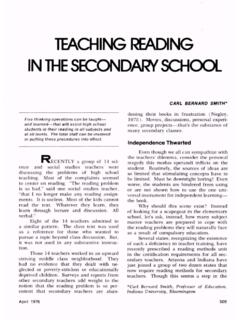Transcription of Appendix G Crosscutting Concepts
1 Appendix G Crosscutting Concepts Crosscutting Concepts have value because they provide students with connections and intellectual tools that are related across the differing areas of disciplinary content and can enrich their application of practices and their understanding of core ideas. Framework p. 233. A Framework for K-12 Science Education: Practices, Core Ideas, and Crosscutting Concepts (Framework) recommends science education in grades K-12 be built around three major dimensions: scientific and engineering practices; Crosscutting Concepts that unify the study of science and engineering through their common application across fields; and core ideas in the major disciplines of natural science.
2 The purpose of this Appendix is to describe the second dimension . Crosscutting Concepts and to explain its role in the Next Generation Science Standards (NGSS). The Framework identifies seven Crosscutting Concepts that bridge disciplinary boundaries, uniting core ideas throughout the fields of science and engineering. Their purpose is to help students deepen their understanding of the disciplinary core ideas (pp. 2 and 8), and develop a coherent and scientifically based view of the world (p. 83.) The seven Crosscutting Concepts presented in Chapter 4 of the Framework are as follows: 1. Patterns. Observed patterns of forms and events guide organization and classification, and they prompt questions about relationships and the factors that influence them.
3 2. Cause and effect: Mechanism and explanation. Events have causes, sometimes simple, sometimes multifaceted. A major activity of science is investigating and explaining causal relationships and the mechanisms by which they are mediated. Such mechanisms can then be tested across given contexts and used to predict and explain events in new contexts. 3. Scale, proportion, and quantity. In considering phenomena, it is critical to recognize what is relevant at different measures of size, time, and energy and to recognize how changes in scale, proportion, or quantity affect a system's structure or performance. 4. Systems and system models. Defining the system under study specifying its boundaries and making explicit a model of that system provides tools for understanding and testing ideas that are applicable throughout science and engineering.
4 5. Energy and matter: Flows, cycles, and conservation. Tracking fluxes of energy and matter into, out of, and within systems helps one understand the systems' possibilities and limitations. 6. Structure and function. The way in which an object or living thing is shaped and its substructure determine many of its properties and functions. 7. Stability and change. For natural and built systems alike, conditions of stability and determinants of rates of change or evolution of a system are critical elements of study. The Framework notes that Crosscutting Concepts are featured prominently in other documents about what all students should learn about science for the past two decades. These have been called themes in Science for All Americans (AAA 1989) and Benchmarks for Science Literacy (1993), unifying principles in National Science Education Standards (1996), and Crosscutting ideas.
5 NSTA's Science Anchors Project (2010). Although these ideas have been consistently included in previous standards documents the Framework recognizes that students have often been expected to April 2013 NGSS Release Page 1 of 17. build such knowledge without any explicit instructional support. Hence the purpose of highlighting them as Dimension 2 of the framework is to elevate their role in the development of standards, curricula, instruction, and assessments. (p. 83) The writing team has continued this commitment by weaving Crosscutting Concepts into the performance expectations for all students so they cannot be left out. guiding Principles The Framework recommended Crosscutting Concepts be embedded in the science curriculum beginning in the earliest years of schooling and suggested a number of guiding principles for how they should be used.
6 The development process of the standards provided insights into the Crosscutting Concepts . These insights are shared in the following guiding principles. Crosscutting Concepts can help students better understand core ideas in science and engineering. When students encounter new phenomena, whether in a science lab, field trip, or on their own, they need mental tools to help engage in and come to understand the phenomena from a scientific point of view. Familiarity with Crosscutting Concepts can provide that perspective. For example, when approaching a complex phenomenon (either a natural phenomenon or a machine) an approach that makes sense is to begin by observing and characterizing the phenomenon in terms of patterns.
7 A next step might be to simplify the phenomenon by thinking of it as a system and modeling its components and how they interact. In some cases it would be useful to study how energy and matter flow through the system, or to study how structure affects function (or malfunction). These preliminary studies may suggest explanations for the phenomena, which could be checked by predicting patterns that might emerge if the explanation is correct, and matching those predictions with those observed in the real world. Crosscutting Concepts can help students better understand science and engineering practices. Because the Crosscutting Concepts address the fundamental aspects of nature, they also inform the way humans attempt to understand it.
8 Different Crosscutting Concepts align with different practices, and when students carry out these practices, they are often addressing one of these Crosscutting Concepts . For example, when students analyze and interpret data, they are often looking for patterns in observations, mathematical or visual. The practice of planning and carrying out an investigation is often aimed at identifying cause and effect relationships: if you poke or prod something, what will happen? The Crosscutting concept of Systems and System Models is clearly related to the practice of developing and using models. Repetition in different contexts will be necessary to build familiarity. Repetition is counter to the guiding principles the writing team used in creating performance expectations to reflect the core ideas in the science disciplines.
9 In order to reduce the total amount of material students are held accountable to learn, repetition was reduced whenever possible. However, Crosscutting Concepts are repeated within grades at the elementary level and grade-bands at the middle and high school levels so these Concepts become common and familiar touchstones across the disciplines and grade levels. (p. 83). Crosscutting Concepts should grow in complexity and sophistication across the grades. Repetition alone is not sufficient. As students grow in their understanding of the science disciplines, depth of understanding Crosscutting Concepts should grow as well. The writing team has adapted and added to the ideas expressed in the Framework in developing a matrix for use in crafting performance expectations that describe student understanding of the Crosscutting Concepts .
10 The matrix is found at the end of this section. April 2013 NGSS Release Page 2 of 17. Crosscutting Concepts can provide a common vocabulary for science and engineering. The practices, disciplinary core ideas, and Crosscutting Concepts are the same in science and engineering. What is different is how and why they are used to explain natural phenomena in science, and to solve a problem or accomplish a goal in engineering. students need both types of experiences to develop a deep and flexible understanding of how these terms are applied in each of these closely allied fields. As Crosscutting Concepts are encountered repeatedly across academic disciplines, familiar vocabulary can enhance engagement and understanding for English language learners, students with language processing difficulties, and students with limited literacy development.

